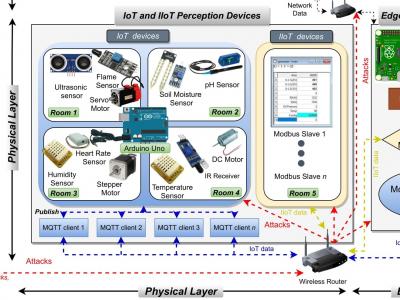Artificial Intelligence
In this project, we propose a new comprehensive realistic cyber security dataset of IoT and IIoT applications, called Edge-IIoTset, which can be used by machine learning-based intrusion detection systems in two different modes, namely, centralized and federated learning. Specifically, the proposed testbed is organized into seven layers, including, Cloud Computing Layer, Network Functions Virtualization Layer, Blockchain Network Layer, Fog Computing Layer, Software-Defined Networking Layer, Edge Computing Layer, and IoT and IIoT Perception Layer.
- Categories:
 19712 Views
19712 ViewsThe fast development of urban advancement in the past decade requires reasonable and realistic solutions for transport, building infrastructure, natural conditions, and personal satisfaction in smart cities. This paper presents and explores predictive energy consumption models based on data-mining techniques for a smart small-scale steel industry in South Korea. Energy consumption data is collected using IoT based systems and used for prediction.
- Categories:
 1881 Views
1881 ViewsWe present a passive stereo depth system that produces dense and accurate point clouds optimized for human environments, including dark, textureless, thin, reflective and specular surfaces and objects, at 2560x2048 resolution, with 384 disparities, in 30 ms. The system consists of an algorithm combining learned stereo matching with engineered filtering, a training and data-mixing methodology, and a sensor hardware design. Our architecture is 15x faster than approaches that perform similarly on the Middlebury and Flying Things Stereo Benchmarks.
- Categories:
 133 Views
133 ViewsThis dataset consists of 2 types of images i.e Authentic and Tampered. There are a total of 1,389 Authentic images and 597 Tampered images. Authentic images are camera clicked images in raw form & tampered images are the one being edited by Adobe Photoshop and few mobile applications. Different types of forgery techniques like copy-move, splicing, color enhancement, resizing etc have been applied on the tampered images.
- Categories:
 2815 Views
2815 Views
This is a dataset regarding the creation of forgery images. The dataset consists of 1000 original and 3000 forgery images generated from the original images. The original images have been retrieved from publicly available repositories. Three different models have been used for creating the forgery images: cut-paste, copy-move, and erase-filling. Both pre-processing (sharpening, color enhancement, resizing, blurring, regulating exposure) and post-processing (sampling, rotation, masking) techniques have been considered for the generation of the forgery images.
- Categories:
 6838 Views
6838 ViewsThe measurement and diagnosis of the severity of failures in rotating machines allow the execution of predictive maintenance actions on equipment. These actions make it possible to monitor the operating parameters of the machine and to perform the prediction of failures, thus avoiding production losses, severe damage to the equipment, and safeguarding the integrity of the equipment operators. This paper describes the construction of a dataset composed of vibration signals of a rotating machine.
- Categories:
 2521 Views
2521 ViewsRemote imaging systems raise unprecedented challenges in artificial intelligence. The dataset provided (extracted from the SpaceNet 6 challenge) shows SAR images having distorted intensities (compared to the expected results, the latter being visible in the RGB and NIR images which are also provided) due to the geophysics of the SAR acquisition system and the geometries of ground objects. Can we teach an Artificial Intelligence to find the right re-projections for automatically correcting such distorted and compressed intensities ?
- Categories:
 228 Views
228 Views
This paper investigates the issue of generating multiple questions with respect to a given context paragraph. Existing designs of question generation (QG) model take no notice of intra-group similarity and type diversity for forming a question group. These attributes are critical for employing QG techniques in educational applications. This paper proposes a two-stage framework by combining neural language models and genetic algorithm for the question group generation task.
- Categories:
 98 Views
98 Views




